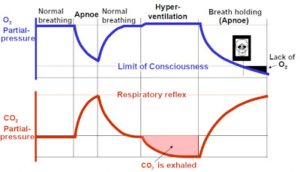Hyperventilation
Hyperventilation is an increase in respiratory rate and lung filling beyond what is actually required. Hyperventilation has hardly any effect on the oxygen level in the body, but lowers the carbon dioxide level.
Basic knowledge for Open Water Diver* (OWD*)

There is always a certain level of carbon dioxide and oxygen in the body tissues. The oxygen is required for the metabolic processes, the carbon dioxide is a waste product and is exhaled.
Both gases must not exceed or fall below a limit. If the oxygen level in our body fall below the lower limit (blackout limit) we lose consciousness. The carbon dioxide level, on the other hand, controls our breathing: An increased CO2 level stimulates the respiratory reflex.
At normal respiratory rates, oxygen and carbon dioxide levels are almost constant. If you hold your breath, the oxygen level drops, whereas the carbon dioxide level increases. However, if this level has reached the mandatory inhalation limit, breathing begins involuntarily. The respiratory reflex kicks in far before the oxygen levels fall below the blackout limit.
If you increase your breathing frequency and you breath deeper as you normally would, this is referred to as hyperventilation. It is commonly believed that the body can absorb more oxygen as a result. In fact, the effect on the oxygen level is negligible since the blood is usually almost completely saturated with oxygen. However, carbon dioxide is increasingly exhaled and the level can become dangerously low, because due to low carbon dioxide levels the respiratory reflex is suppressed.
If you now hold your breath, the oxygen level can easily drop below the blackout limit before the respiratory reflex is triggered by the still too low carbon dioxide level. This is intensified on prolonged distance or deep diving without a scuba gear in the ascent phase, since the oxygen partial pressure drops due to the decreasing depth and ambient pressure. Unconsciousness occurs (so called shallow water blackout). If the victim is not immediately rescued from the water, there is an acute risk of drowning, since during the phase of unconsciousness the carbon dioxide level reaches the inhalation limit and the respiratory reflex is triggered.